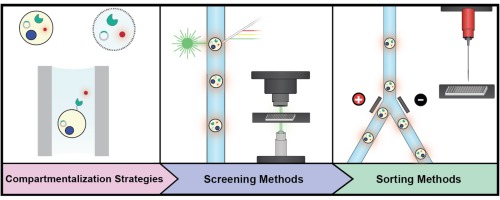High-throughput enzyme screening is a cutting-edge biotechnological method employed to effectively analyze and pinpoint enzymes possessing specific desired traits from a vast array. This innovative approach has become indispensable in drug discovery and biocatalysis, enabling scientists and researchers to swiftly evaluate thousands or even millions of enzymes simultaneously. By harnessing and implementing high-throughput enzyme screening, we can expedite the creation of novel and efficacious drugs, optimize industrial processes, and foster the advancement of scientific understanding.
 High-throughput screening technologies for enzyme engineering (Chelsea K Longwell, et al., 2016)
High-throughput screening technologies for enzyme engineering (Chelsea K Longwell, et al., 2016)
Technical Route
The technical route for high-throughput enzyme screening is a comprehensive, multi-step process, meticulously designed to maximize efficiency and accuracy. This process is fundamental to advancements in biotechnology, pharmaceuticals, and other industries that rely on enzyme innovation.
| Step Name |
Objective |
Description |
| Library construction |
To generate a diverse library of enzyme variants |
This step involves utilizing sophisticated genetic and biochemical techniques to create a vast library of enzyme variants. The library, rich in diversity, serves as the foundation for subsequent screening processes. |
| High-throughput screening |
To screen enzyme variants on a large scale under desired conditions |
Utilizing advanced equipment and methodologies, this step enables the simultaneous testing of thousands or even millions of enzyme variants. The high-throughput approach ensures thorough examination, minimizing the risk of overlooking potential candidates. |
| Hit validation |
To validate positive hits obtained during screening |
Positive hits, i.e., enzyme variants showing promising results during screening, undergo rigorous additional tests and analyses. This validation phase aims to confirm their potential and reliability for further consideration. |
| Data analysis |
To analyze the results obtained from screening and validation processes |
This final step involves meticulous analysis of the data using advanced statistical and bioinformatic tools. The goal is to identify potential candidates for further study or application. It's crucial for understanding the implications of findings and planning subsequent research or product development steps. |
Service Process
Our high-throughput enzyme screening process involves a series of carefully executed steps to ensure optimal results. These steps include:
- Initial consultation: Our process starts with a comprehensive dialogue with the client. It's during this consultation that we delve into the specific needs, goals, and expectations of the client. We strive to comprehend the client's vision explicitly to customize an approach that aligns perfectly with their requirements.
- Design of a customized screening strategy: After gaining a thorough understanding of the client's needs, we proceed to design a tailor-made screening strategy. This strategy is meticulously crafted, taking into consideration all the unique needs and goals of the client's project. This careful design process is geared towards maximizing the probability of successful outcomes.
- Implementation of high-throughput screening: Following the strategy design, we implement the screening process. We employ state-of-the-art equipment and the latest techniques to facilitate this intricate process. This step ensures that our screening process is both efficient and effective, capable of identifying promising enzyme variants.
- Validation of positive hits: Any positive results that emerge from the screening process are then subject to further testing and analysis. This step is crucial in ascertaining the validity and potential of these positive hits. It involves a rigorous examination to confirm their relevance and viability for the client's objectives.
- Data analysis and reporting: After the screening and validation processes, we undertake a comprehensive analysis of the results. This involves meticulous scrutiny and interpretation of the data to derive significant insights. A detailed report, offering clear findings and actionable recommendations, is then prepared and shared with the client.
We're here to assist you. If you have any questions, need more information, or would like to discuss a potential project, please don't hesitate to contact us. Our team is always eager to help and share our expertise.
Applications
High-throughput enzyme screening can be applied in various fields like drug discovery, biocatalyst identification for industrial processes, enzyme evolution studies, and more. We can provide high-quality, efficient screening services for clients in these areas and beyond. Here are some key application areas of High-Throughput Enzyme Screening along with brief descriptions:
| Application |
Description |
| Drug Discovery |
High-Throughput Enzyme Screening is widely used in drug discovery to rapidly screen large libraries of compounds to identify potential enzyme inhibitors or activators. This aids in the development of new therapeutics for various diseases by targeting specific enzymes involved in pathological processes. |
| Bioprocessing |
In bioprocessing, High-Throughput Enzyme Screening is utilized to optimize enzyme performance for industrial applications such as biofuel production, food processing, and pharmaceutical manufacturing. It enables the identification and characterization of enzymes with desirable properties, leading to improved process efficiency and product quality. |
| Agriculture |
High-Throughput Enzyme Screening plays a crucial role in agricultural research by facilitating the discovery of enzymes involved in plant metabolism, nutrient uptake, and defense mechanisms. This technology aids in crop improvement efforts, pest management, and soil health maintenance by identifying enzymes with potential applications in agriculture. |
| Environmental Remediation |
This screening method is employed in environmental remediation to identify enzymes capable of degrading pollutants and contaminants in soil, water, and air. By accelerating the discovery of biocatalysts for environmental cleanup, High-Throughput Enzyme Screening contributes to the development of sustainable solutions for pollution control and ecosystem restoration. |
FAQs
Q: What types of enzymes can be screened?
A: Essentially, any enzyme that can have a suitable assay developed for it can be included in the screening process. The flexibility and adaptability of this method allow for the screening of an extraordinarily wide variety of enzymes, spanning from those involved in basic metabolic processes to those with highly specialized functions.
Q: How many enzymes can be screened at a time?
A: The number of enzymes that can be screened concurrently largely depends on the method and technology employed. With the use of advanced high-throughput screening techniques, it is feasible to screen from thousands up to millions of different enzymes simultaneously. This immense screening capacity is one of the standout advantages of high-throughput enzyme screening, enabling rapid and extensive analysis.
Q: How long does the screening process take?
A: The duration of the screening process can fluctuate notably depending on several factors, including the total number of enzymes being screened and the complexity of the assay. Nonetheless, high-throughput techniques are explicitly designed to significantly speed up the process as compared to traditional methods, making it possible to conduct large-scale screenings in a relatively short time frame.
Q: How are the enzymes for screening selected?
A: The selection of enzymes for screening is typically guided by their relevance to the research question at hand or the specific industrial application being explored. By focusing on enzymes that are likely to be significant in the context of the intended study or application, the screening process becomes more targeted, efficient, and productive.
Q: What happens after an enzyme of interest is identified?
A: Once an enzyme of interest is identified from the screening process, it becomes the subject of more intensive study and optimization for specific uses. Depending on the identified enzyme's properties and potential, this could include various applications such as use in drug discovery processes, incorporation into industrial procedures, or as a focus for further in-depth scientific research.
Q: Can high-throughput enzyme screening be used for drug discovery?
A: Absolutely, high-throughput enzyme screening is a foundational tool in the realm of drug discovery. It provides the means for the swift identification of enzymes that could potentially serve as targets for the development of new therapeutic drugs, thus playing an instrumental role in the advancement of medical treatments.

































 High-throughput screening technologies for enzyme engineering (Chelsea K Longwell, et al., 2016)
High-throughput screening technologies for enzyme engineering (Chelsea K Longwell, et al., 2016)